River
Diving:
The Vector Approach To Navigation
by
Larry
"Harris" Taylor, Ph.D.
This
is an electronic reprint and expansion of the article that appeared in NAUI News
(Mar/Apr. 1988, 18-21). This material is copyrighted. All rights are retained by
the author. This article is made available as a service to the diving community
by the author and may be distributed for any non-commercial or Not-For-Profit
use. All
rights reserved
Go
To: Home About
"Harris" Articles
Slides
War Stories
Editorials
Links
Fini
Many
diving students are intimidated by the art of navigation. After all, most
navigational texts are filled with seemingly complex and rigorous mathematical
equations. When one adds to this the wizardry and rituals often associated with
at-sea navigation, it is easy to understand why students are so intimidated by
the subject of navigation, that they fail
to see how simple much of practical navigation can truly be.
Historically,
there was a reason to make navigation appear complex and
beyond the realm of all but the most gifted of sailors. The reason for the
deception of those practicing the navigational arts was simple: survival. The conditions of early sailing vessels were often less than humane and
the ritual of navigation prevented many a mutiny. As a matter of fact,
many ship's masters often went to great lengths to ritualize the art of
navigation in an effort to convince ordinary seaman that they could never master
the art. No matter how distastefully the sailors felt they had been treated,
rebellion against the captain and mate was a mutiny against those who were the
only ones capable of finding the way home. Thus seaman endured, rather than
dispose of the way home. For the most part, scuba instructors are not worried
about such open rebellion and there should be no need to perpetuate the myth
that navigation is exceedingly complex and difficult.
First
of all, navigation by any technique, is not foolproof! Navigation (the
art of safely going from one place to a second desired location) really boils
down to the art of estimating and correcting errors. Navigational techniques
apply certain assumptions such as:
1.
the diver swims at a constant rate of speed in a straight line and
2.
currents are constant in both speed and direction.
However,
since Mother
Nature, the Diver and "Murphy's Law" do not really operate in such a
manner, all navigation techniques should be viewed as a "best guess"
estimate. The trick is to make that guess come close to reality. Experience
with self in the water environment, Mother Nature and Murphy will allow one to
know the conditions under which the various navigational techniques will be
useful.
In
order to estimate a diver's position in a current with time, one must
first know the speed at which the diver swims. Typically, this is
determined by having the diver swim 100 ft along a measured line with
no current influences. (My students swim 3 separate 100 ft. lengths
and determine the average number of kicks, the time taken, and the
air consumed.) Next, one must know the speed and direction of the
current. In coastal situations this can be estimated by consulting
tide tables. There are procedures and separate tables for estimating
both horizontal and vertical water movement in a tidal zone. In the absence of
instrumentation, a commonly employed in a river situation method involves
trailing a
float on a 100 ft. line behind an anchor point or, more simply, marking a 100
foot segment on land and having an observer note the taken to float the length
of the measured line. The current speed can then be calculated or estimates can
be made from
a current speed table as shown below.
Speed
As a Function of Time Taken To Travel 100 Feet

A
bearing from the anchor
point to the float gives the direction to which the current is moving.
The current direction is this value. (Wind directions are reported from
where they originate, current directions are reported in the direction
to which they are moving.)
We will examine two different approaches to dealing with currents. The
first (and by far, the most common ) is to assume that there is no
effect and that the diver need not concern himself with them. Let
us assume
a macho diver wishes to explore an old river steamer that lies due north
(course 000) of his convenient entry point 500 ft offshore. There is a
current of 50 ft/min (about 1/2 knot) moving towards true bearing
075 (the current direction is thus 075; current
directions are given as the direction to which they move). The
situation is shown below:

The
diver just finished a scuba class and thus we know that he swims
a 100 ft. distance in 1.5 minutes. This diver is a very powerful person
on land and thus he assumes that his physical prowess will allow him
to swim directly to the wreck. So, he enters the water. Let's see
what effect the current will have on this macho diver.
We estimate his speed:
1.5
min / 100 ft => 100 ft / 1.5 min = 66.7 ft/ min
We
estimate his travel time to the wreck:
500
ft /
66.7 ft/min =
7.5 min
We
now resort to vectors. A vector is merely a line that is
drawn to scale that conveys information of both magnitude (how much?)
and direction (to where?). Although it is possible to do our
estimations using simple or not-so-simple trigonometric equations,
drawing lines with a ruler and protractor on graph paper (or better
yet, the actual nautical chart) is simpler and for the most part faster.
We begin by drawing a line which represents the diver moving through
the water. This line is drawn in the direction the diver swims (due
north, course 000) and is 66.7 units long. The actual size of a unit
is unimportant; what is important is that all additional lines are of the
same scale and units. (For example one does not plot mph with ft / min.)
Our line is 66.7 units long because our macho diver is swimming at
a rate of 66.7 ft / min. We place
an "arrow head" on the "northern"
end because this is the direction our diver is moving.
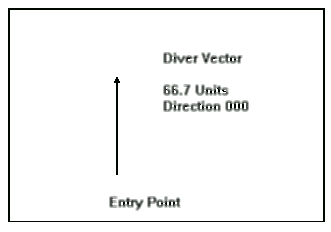
Next,
we draw a line representing the effect of the current on our
diver. This line is 50 units long (for 50 ft / min ) and is drawn
heading in the direction 075. Note that we place the "tail" of the
current vector on the "head" of the diver speed vector. (We are
actually performing vector
addition.)
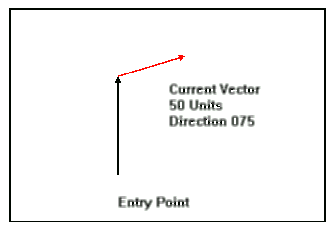
Then,
we draw a "resultant" (connect point E, the entry point,
to R, the result). This line represents the effect of the current on
the path the diver will swim. In other words, a diver swimming at a heading of
000 at a constant speed of 66.7 feet per minute under the influence pf a
50 feet per minute current directed towards true course 075 will swim along a
path approximated by the resultant line.
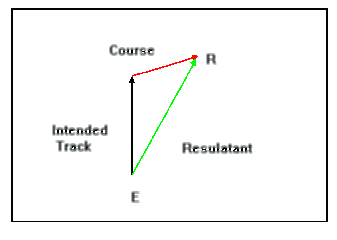
Since
we very cleverly chose
our units so that each separate vector was one minute in time, we can
estimate the macho diver's position after swimming 7.5 minutes by using
dividers (or a ruler). We measure the distance E to R and then measure
7.5 times this distance from E along an extended resultant line. This
position (D, for disaster) represents where macho man will be when
he thinks he should be at the wreck. Measuring (to scale) the distance
from the wreck to D indicates the macho man to be about 380 ft. from
the wreck.
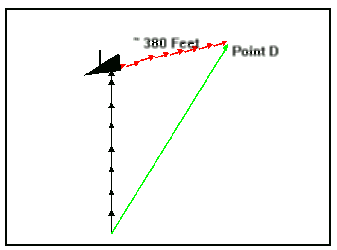
This
explains why macho diver surfaced so far from the wreck.
Fortunately,
his great physical prowess made the walk back to the
entry point with his gear no big deal.
Another
diver, Wimpy, decides to make this dive. He knows it is
possible to partially counteract the force of the current by swimming
at an angle into the current. He uses a ruler, protractor, and a
drawing compass to determine his course. First, he draws a long line
in the direction he wants to swim. In this case, course 000 or due
north. This line is called the intended track. He labels the
entry point E.
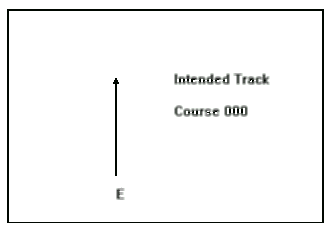
Next,
he draws a current vector 50 units long (for 50 ft/ min)
FROM THE ENTRY POINT, E, towards true direction 075. This point, R,
represents the effect of the current on the diver with the diver
doing no swimming.
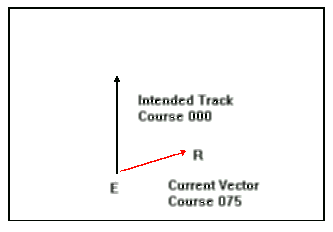
Using
a drawing compass, Wimpy draws an arc of radius 66.7 units
representing his speed of 66.7 ft / min. (Fortunately for this
example, Wimpy and macho man swim at the same speed; Wimpy just uses
1/3 the air!) using point R as the center point. This arc intersects
the intended track at point I.
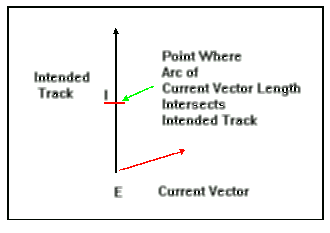
Now,
he draws a line from point R to the intersection point, I.
This line represents the course needed to follow at a constant speed
of 66.7 ft/min in order to counteract the effect of the current
and to swim along the intended track. In this case, the line corresponds
to a true course of 315.
Although he will be swimming facing heading 315, his actual path
will be along the intended track.
The last navigating step before the dive is to determine the
compass course to be used. Since Wimpy lives in an area where the
variation is 003 E, he sets his compass bezel for a course of 312.
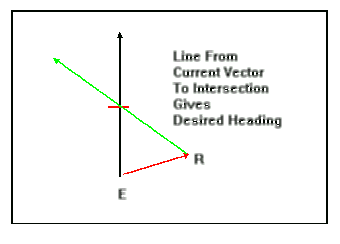
Summary:
In order to swim to a wreck that lies 500 ft due north
in a constant current of 50 ft/ min moving toward a true direction of
075, it is necessary for a diver to swim at a compass course of 312 at a
constant
speed of 66.7 ft / min.
Wimpy and his buddy made the dive and discovered that the rumors of
gambler's gold aboard the wreck were based on fact. Wimpy now is driven
to the dive site and does his plotting with platinum dividers.
Several
weeks later after spring rains, both divers returned to
the same spot. However, the current is now 300 ft / min (about 3 knots).
Macho man entered the water, figuring that by swimming straight into
the current, he would manage to find the wreck. Wimpy, using his
platinum dividers analyzed the situation using vectors.
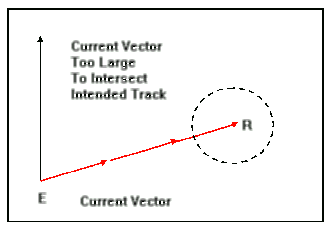
In
this case, the diver speed radius does not intersect the intended
track. This means that it is not possible for the diver to make the
intended dive under the conditions specified. Thus, there is no way
(without mechanical assistance) for this dive to be made from this
entry point.
Wimpy decides he wants to dive and uses vectors to help determine
a new entry point. Starting from the wreck, he draws the reciprocal
of the current vector (300 units in direction 255). To this, he adds the
reciprocal of his speed vector (66.7 units in direction 180).
He then extends the resultant line to shore on the chart.
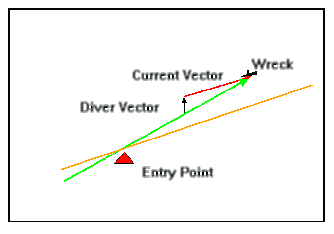
Here,
the line crosses shore about 1080 feet upstream from the
point where macho man was last seen. This is his new entry point. Although
Wimpy has calculated that the dive was possible (on paper), he
decides he has not yet had enough experience to make a dive in this current.
If
there would have been no intersection of the resultant line
with shore, then other options must be considered:
a.
swim faster to increase the diver's speed vector
b.
use a DPV
c.
convince someone to lay cable guidelines to the wreck
d.
buy a boat
e.
dive from someone else's boat
f.
abort the dive.
Conclusion
The
vector method of estimating a diver's position in current
is not perfect. It assumes that factors stay constant when we live
in a universe of constant variability. However, it does provide a
basis for reasonable estimation. In fact, as long as the distance involved
is short, this method provides excellent correlation with reality. Lou Fead
(The "Easy Diver") said it best, "Dive with your brains, not
your back!" If
you dive in current, using graph paper, a compass, a protractor, and a few
drawn lines can save you hours of frustration in the water, as well as
eliminating some very long walks back to entry points.
This
is one portion of series of articles on river diving. Others are
River
Diving: Reading Rivers
River Diving: Equipment
River Diving: Technique
Lecture
Slides for the river diving course at River
Top
Go
To: Home About
"Harris" Articles
Slides
War Stories
Editorials
Links
Fini
About
The Author:
Larry
"Harris" Taylor, Ph.D. is a biochemist and Diving Safety Coordinator
at the University of Michigan. He has authored more than 200 scuba related
articles. His personal dive library (See Alert Diver, Mar/Apr, 1997, p. 54) is
considered one of the best recreational sources of information In North America.
Copyright 2001-2024 by Larry "Harris"
Taylor
All
rights reserved.
Use
of these articles for personal or organizational profit is specifically denied.
These
articles may be used for not-for-profit diving education












